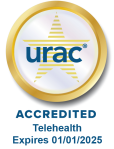Tick bites left untreated can quickly turn more serious, and lead to other medical issues, such as Lyme disease.

HELP FROM UCM ON REMOVING A TICK FROM A CHILD’S NECK
The mother of a 12-year-old boy named James called in to United Concierge Medicine, concerned that she’d just found a tick with a ‘huge back end’ stuck to the back her son’s neck. James and his friends had been outside earlier that day playing in the nearby wooded area—and she knew that it was important to remove this tick from right away.
The UCM emergency medical provider asked if Mom would be willing to set up a video chat in order to further assess and assist with her son, and she said she’d feel much more reassured to do just that, so she happily agreed; within minutes, she was on a video chat with the UCM emergency medical provider.
Right away, the UCM provider could see a large dog tick present and it was moving its legs. Mom, anxiously awaiting guidance on what to do next, mentioned she had a tick remover, but was unsure exactly how to use it.
PROVIDING VIRTUAL CARE RIGHT AWAY
The UCM emergency medical provider discussed the importance of removing the tick quickly and completely in order to have the best chance of preventing tick-borne disease; but he reassured her that using her tick remover, along with his instructions, she’d be able to remove the tick.
Note: A tick removal device can be obtained from a pharmacy, but a simple pair of tweezers will also work just as well.
With the tick removal device in hand—and James holding very still—the UCM emergency medical provider instructed the mother to get the tweezers as close to the tick head attachment point as possible, and to pull with gentle and even pressure up until both of the hooks on the tick’s head released.After a few seconds, the mother was successful in removing the tick and showed the site to the UCM provider who was able to verify her success. He instructed her to immediately wash the tick bite area with an alcohol wipe. James was very happy that the tick was painlessly, and quickly, removed!
FOLLOW-UP CARE AND INSTRUCTIONS
Since the tick had not been in place for more than 24 hours, James had a low chance of contracting tick-borne disease of any kind, and therefore, did not need an antibiotic regimen. However, the UCM emergency medical provider explained, the mother needed to mark down the “tick bite day” on a calendar so she could monitor James for the next six weeks; should a patient develop a fever or rash any time within six weeks or so after a tick bite, they should be re-evaluated by a medical provider.
Both James and his mother were relieved to have the situation taken care of quickly and under the watchful eye of the UCM emergency medical provider … and without a trip to the urgent care or emergency room. In a follow-up call, the mother reported that James has had an uneventful post-bite timeframe, and says that he’s not let inside from playing without a thorough body-check to screen for ticks!
DO YOU KNOW WHAT TO DO WHEN YOU SEE A TICK ON YOUR SKIN?
- Use fine-tipped tweezers to grasp the tick as close to the skin’s surface as possible.
- Pull upward with steady, even pressure. Don’t twist or jerk the tick; this can cause the mouth-parts to break off and remain in the skin. If this happens, remove the mouth-parts with tweezers. If you are unable to remove the mouth easily with clean tweezers, leave it alone and let the skin heal.
- After removing the tick, thoroughly clean the bite area and your hands with rubbing alcohol or soap and water.
- Never crush a tick with your fingers. Dispose of a live tick by putting it in alcohol, placing it in a sealed bag/container, wrapping it tightly in tape, or flushing it down the toilet.
*information from the CDC
Learn more about Lyme disease from the Centers for Disease Control






